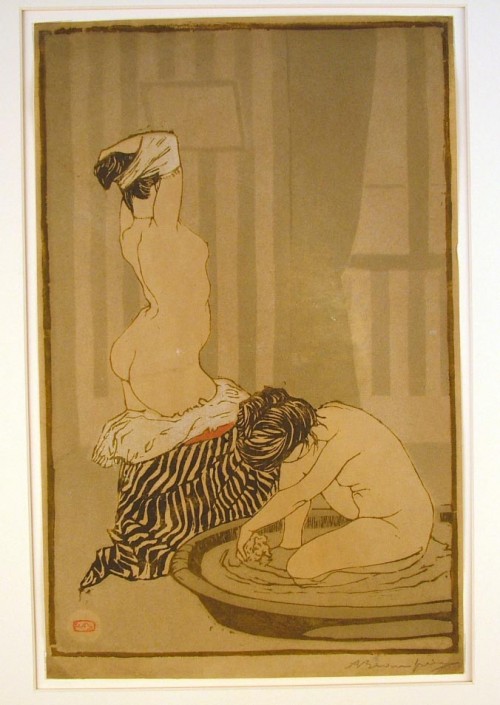Femmes au Tub (Women Bathing)

Adolphe Beaufrere (1876-1960), Femmes au Tub (Women Bathing), c. 1902, colored woodcut, signed in pencil, also with the artist’s red monogram stamp. Reference: Morane B-1; Musee des Beaux Arts de Renne 1. On brown Japon paper. Printed in dark brown, orange, tan and light blue. 13 1/2 x 8 7/8 inches. Trimmed just outside of the borderline. Soft creases upper left and associated slight rubbing, 2 soft folds upper right corner, soft creases lower left, soft fold near left border, a few rubbed or lightly printed areas in image.
Provenance: acquired directly from Jean-Noel Beaufrere, the artist’s son.
A fine impression of this great rarity, Beaufrere’s first woodcut and arguably his greatest work in printmaking.
We know of no other impressions of Femmes au Tub appearing on the market in recent history; the impression in the Musee des Beaux Arts de Rennes is presumably the impression appearing in Morane’s catalog raisonne (it appears to have condition problems, including scattered ink markings and creases, far exceeding those of the present impression). Morane does not call for any proposed edition. One surmises that Beaufrere had problems printing this print which prevented him from making more than a few proofs, but aesthetically it was a great success.
Beaufrere was born at Quimperle, in Brittany, and though he traveled widely he re-connected with this area throughout his life. As a teenager he decided that he wanted to become an artist and he traveled to Paris where, shortly after his arrival, he encountered the eminent Gustave Moreau, who took him on as a student. Moreau encouraged him to study old master prints, especially the prints of Rembrandt and Durer, which were available in the Cabinet des Estampes in Paris – this was to be critical in his development. He was also influenced by the stirrings of modernism in Paris at the time, as well as the Japanese woodcut tradition and the French frenzy with Japonisme, of course evident in Femmes au Tub.
Beaufrere began printmaking near the end of his formal training, and Morane indicates that Femmes was made at this time, in 1902; he made a number of other woodcuts, but soon focused more on etching and engraving, as well as painting (curiously, one of his printmaking teachers at that time was the Canadian etcher Donald Shaw MacLaughlan). He began showing his prints, with some success, but after his marriage in 1905 his new wife convinced him to move out of Paris and back to Brittany, a move having a mixed effect on his career – contacts with other artists became fewer, but he did maintain gallery relationships, and the French countryside and it’s inhabitants would provide a continuing source of inspiration.